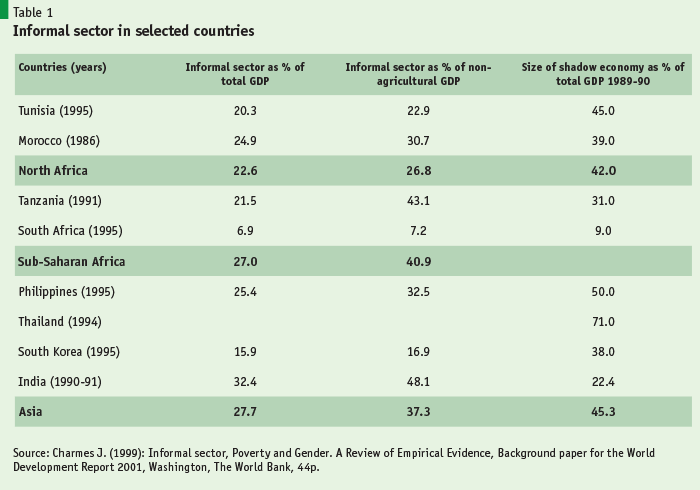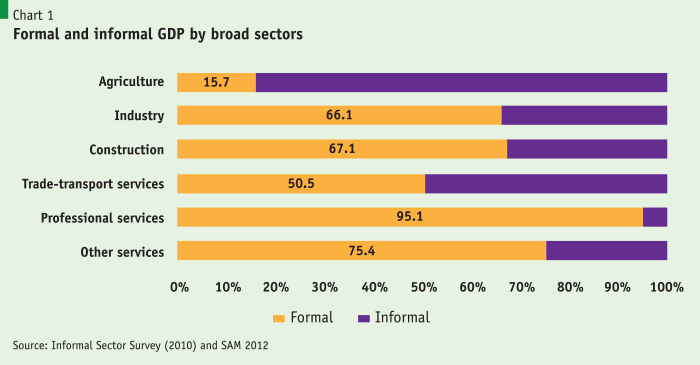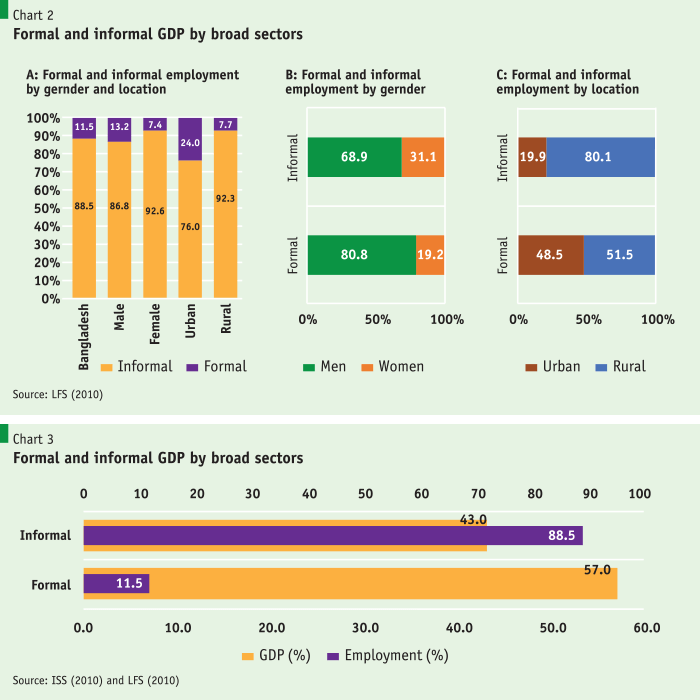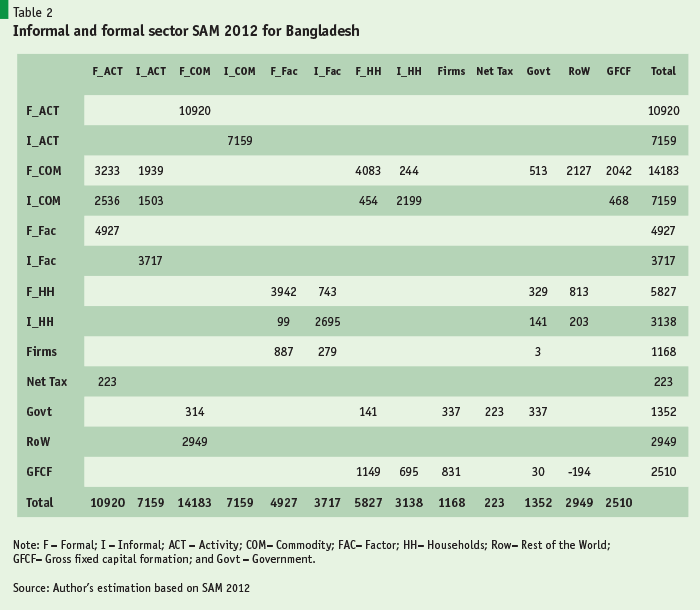Insights into the informal sector in Bangladesh
By
In developing economies informal sector plays an important role in the generation of income, employment and absorption of surplus labourers, especially during economic downturn or economic transition. Despite its importance, measurement of informal sector is seldom attempted. Accordingly, an important concern in economic development is the measurement of the informal sector and its association with the formal sector – especially in the process of growth.
The International Labour Office (ILO) in 1993 introduced the concept of the informal sector in their XVth International Conference of Labour Statisticians held in Geneva (ILO, 1993). However, long back in early 1970s the first multi-criteria definition of the notion of the informal sector was proposed by ILO in its famous report on Kenya for the World Employment Programme (ILO, 1972). System of National Accounts (SNA) produced by the UN in 1993 which has been followed by member countries for the GDP estimation has also modified the methodology to account for the informal sector. 
Following these developments some developing countries have tried to estimate the contribution of the informal sector in total national income (Table 1). The estimates of selected countries suggest the share of information sector as percent of GDP are in the range of 23% (North Africa); 27% (Sub-Saharan Africa) and 28 % (Asia).
Although informal labour market characteristics have been attempted in Bangladesh by BBS, further dissection of informal sector’s GDP size; importance in growth process and association with the formal sector have not been attempted. This article is an attempt to go beyond the informal sector assessment based on the labour market to understand the contribution of this sector in income generation and growth. Data from labour force survey (2010), the informal sector survey (2010)1 and formal-informal social accounting matrix developed for 2012 have been used.
Production structure
Size of the informal sector in GDP by broad sector classification envisages some interesting insights:
- Agriculture is mostly informal with a share of almost 85%.
- Almost one third of the industry and construction GDP has been generated in the informal sector.
- Trade and transport services is slit into half in term of formalisation of the sector
- Services are predominantly formal with informal sector share of around 5% to 15%.
When we combine the informal GDP of all these broad sectors, the total GDP size of the informal sector is 43% of FY2012 GDP. Bangladesh’s informal sector GDP size is thus larger than the informal GDP size of some of the Asian countries listed in Table 1. This may be the result of the time differences between the two estimates – estimate of 28% informal GDP for the Asian countries was for early 1990s. Between 1990 and 2012, all these Asian countries registered massive economic expansion, perhaps along with an increasing share of their respective informal sector. Rada (2010)2 pointed out these associations and argued that stylised facts from many developing countries highlight an increase in the share of the informal sector during their economic expansion.
Employment
Labour Force Survey (LFS) has been analysing labour market characteristics both from formal and informal sector perspectives. Some of the key features of labour market in Bangladesh are presented in Chart 2. It contains three panels. Panel A captures formal and informal employment by gender and location. It clearly depicts that almost 88% of employment in Bangladesh has been accounted for by the informal sector. Informal employment is more than 92% for female and rural employment. Informal and formal employment by gender has been shown in Panel B. Due to low female participation rate in the labour market, although both formal and informal employment are dominated by male employment, male share is significantly larger in the case of formal employment. Only 19% of the female work force is in formal sector employment. The last panel (Panel C) captures formal and informal employment by location. Not surprisingly, rural employment is mostly informal due to large informal agriculture. What is surprising is the larger share of rural employment in the formal sector employment. Perhaps, this is due to many of the formal activities being located in rural locations to cater to the rural needs.
Due to low female participation rate in the labour market, although both formal and informal employment are dominated by male employment, male share is significantly larger in the case of formal employment.
Formal and informal employment have been contrasted against their GDP values in Chart 3 to assess average returns to labour is these two sectors. Some important features were revealed from the comparison. Informal sector, which accounts for 43% of GDP, absorbs almost 88% of the total employment. On the other hand, formal sector only employs around 12% of total employment even though it accounts for 57% of the total GDP. This large imbalance is detrimental to productivity, decent work generation and the economic expansion. A key challenge is to strike a balance between these two sectors with respect to income generation and labour absorption.
Formal and information sector linkages
To assess the association between the formal and informal sectors in Bangladesh, the Bangladesh SAM 2012 has been further separated into formal and informal blocks using information of Bangladesh Informal Sector Survey and Labour Force Survey data of 2010. The two sector (formal and informal) SAM for 2012 is presented below.
SAM 2012 reveals some important interdependence between these sectors. The formal sector provides inputs of Tk. 1,939 billion to the informal sector and uses own outputs of Tk. 3,233 billion as its own inputs. 
Households in the formal sector purchase final goods from the formal sector amounting to Tk. 4,546 billion while their purchase from the informal sector is only Tk. 244 billion. Households in the informal sector purchase mainly from the informal sector amounting to Tk. 2,199 billion. Thus, households of these two sectors rely mainly on the commodities supplied by their respective sectors.
Informal sector pays no taxes on its activities suggesting that the formal sector is bearing the burden of all tax incidence in Bangladesh.
Informal sector pays no taxes on its activities, suggesting that the formal sector is bearing the burden of all tax incidence in Bangladesh.
Although the data SAM provides some insights into their association, the depth of this association and their contribution to the growth process are not clear. Such an assessment requires the use of multipliers derived from a SAM model. Accordingly, the data SAM is converted to a SAM multiplier model to generate multipliers. SAM multipliers provide backward linkages for the formal and the informal sectors.
Formal activity has higher backward linkage (i.e. 2.76) than the informal activity (i.e. 2.60) implying slightly higher importance for the former than the latter in the economic generation process. Furthermore, the off-diagonal elements of the activity – activity account suggest similar level of dependency between them in terms of the provision of the intermediate goods. Formal activity purchases 0.37 units from informal sector while informal activity needs 0.41 units of intermediate goods from the formal sector. However, commodity backward linkage has been found higher for the informal sector (i.e. 3.60) than the formal sector (i.e. 3.13) mainly due to smaller leakages from the informal sector in the form of tax payment and payments for imported goods and services. 
These results suggest that policies that intend to expand economic activities in Bangladesh should emphasise stimulating demand in both of these sectors – perhaps almost equally.
Bangladesh should focus on strategies that would try to increase labour productivity in the informal sector and thereby boost economic growth.
Concluding observations
- The above analysis suggests that informal sector is important for the economy of Bangladesh for both income and employment generation. This turns out to be the key sector as generator of jobs and absorber of surplus labour.
- Bangladesh should focus on strategies that would try to increase labour productivity in the informal sector and thereby boost economic growth.
- In order to stimulate economic expansion Bangladesh needs policies that attach emphasis on both the formal and the informal sectors.
Notes
- LFS 2010 has been used to maintain correspondence with the ISS which was conducted for FY2010. The size of information employment in LFS is still high at around 86% compared to 88% reported in LSF in 2010.
- Rada, C (2010), Formal and Informal Sectors in China and India. Economic Systems Research, 22, 315-341.





